Statistical bulletin - Crime and Justice series: Prison statistics Scotland 2010-11
This bulletin shows data up to 2010-11 on Scottish prison population level and characteristics, receptions to/liberations from Scottish prisons, and international comparisons.
This document is part of a collection
3. Main findings
Prison population
4. After the steady increase observed since 2000-01, the prison population [1] has dropped slightly to an annual daily average of 7,853 for 2010-11 ( Table 1). This represents a fall of 1 per cent from the previous year, and suggests that the prison population has stabilised in the short term although levels remain very high in relation to the current design capacity of about 7,330 [2].
5. It is difficult to tell at this stage whether we are seeing the beginning of a longer term levelling out of the prison population, as this has shown short-term peaks and troughs over the past 20 years while the underlying longer term trend has been upward ( Chart 2). The latest long-term projections suggest a continuing upward trend over the next ten years, and these are discussed in more detail in Scottish prison population projections: 2010-11 to 2019-20, along with potential drivers of the recently observed trends. It is also interesting to note that the rise in the prison population over the past five years or so is set against a backdrop of relatively stagnant or falling levels of recorded crime [3].
Chart 2 Average daily prison population (Scotland): 1980 to 2010-11
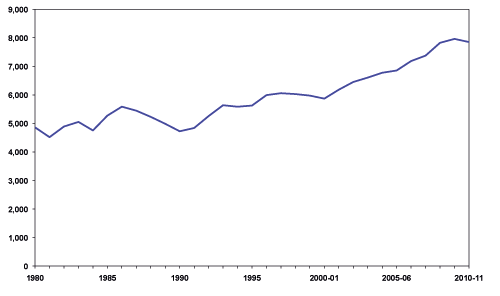
6. At a general level, there are several drivers behind the increase in prison population over the past couple of decades:
- increase in convictions for more serious offences and increased sentence lengths driving the general upward trend of the long-term prison population
- increase in the number of convicted offenders getting custodial sentences for lower tariff crimes and offences, coupled with improved efficiency of the criminal justice system, driving the increases in the short-term population seen during 2008 and 2009
- increased numbers of prisoners held on remand between 2006-2007 and 2008-09
- increased numbers of recalls from supervision or licence over the past ten years, although this group accounts for a relatively small proportion of the population.
7. The current dip is primarily due to marked drops in the young offender population for both remand and direct sentenced (excluding fine default and recall) prisoners by 14 and 17 per cent respectively ( Table 1, Chart 3).
Chart 3 Average daily prison population by category of prisoner: 2001-02 to 2010-11
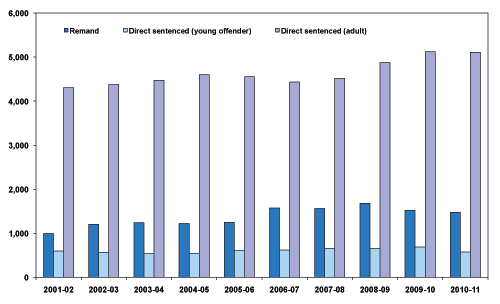
8. Overall, the sentenced population has dropped by 1 per cent, reaching 6,378 in 2010-11. This is due to a decrease across most sentence groups, apart from the life sentence and recall populations which have increased by 5 and 10 per cent respectively ( Table 3).
9. Prisoners on remand or recalled from licence or supervision currently constitute just over a quarter of the prison population, although these categories have shown disproportionate increases over the past decade. The picture has become somewhat more complex over the past few years. The current annual rate of growth for the recall population has increased to 10 per cent, reaching 682 during 2010-11, while the remand population has fallen by 3 per cent to 1,474 ( Table 1).
10. Untried prisoners form the bulk of the remand population, 1,112 compared to 362 for remand prisoners who have been convicted but not sentenced. The untried population has gone down over the past year by 5 per cent, while the population of convicted remand prisoners awaiting sentencing shows an increase of 3 per cent. As mentioned below in §18, remand receptions have been drifting downward over the past few years, and it is likely that a focus on achieving the current 26 week target for dealing with criminal cases in sheriff summary and district courts will have contributed to the fall in the population of untried prisoners.
11. During 2010-11, the average daily population decreased by 2 per cent to 7,419 for men, while the female population increased by 3 per cent to 435. The young offender population showed marked drops for both remand and direct sentenced (14 and 17 per cent respectively) ( Table 1). Trends for women and young offenders are discussed in more detail in Scottish prison population projections: 2010-11 to 2019-20 (Annex A), and the Scottish Government has recently set up a commission to find a more effective way of dealing with women offenders with a view to reducing reoffending.
12. Most of the population figures reported in this bulletin are annual daily averages during 2010-11: the population peaked at 8,096 in May 2010 ( Table 2). More generally, seasonal effects and a range of other, potentially unforeseeable, events may result in short-term fluctuations in the prison population which can be of the order of +/- 300-400. The prison estate has to accommodate prisoners with differing needs, for instance, remand/sentenced, short/long term, as well as those at different stages of progression and security levels. Some groups need to be segregated, such as women and young offenders, and fluctuations in these groups therefore cause additional service delivery problems [4].
Population profile
13. The prison population on 30 June 2010 was 7,983, of which 95 per cent were men ( Table 4). The age profile of women prisoners tends to be somewhat older than that for men ( Chart 4).
Chart 4 Age distribution of prisoners by sex: 30 June 2010
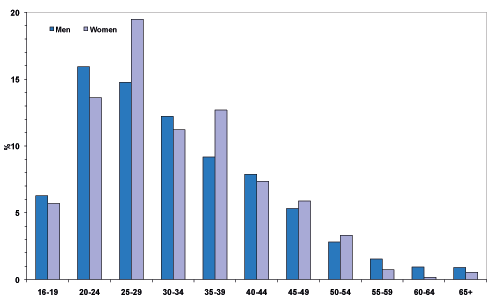
14. Three fifths of the prison population had a medium supervision level, and 7 per cent had a high supervision level. The remaining third had a low level of supervision ( Table 4, see Section 5 for details on supervision levels).
15. The crime category with the largest population of sentenced prisoners on 30 June 2010 was non-sexual violent crime (36 per cent), followed by the other crimes category (21 per cent). This category consisted mainly of drugs-related crimes, which make up 14 per cent of the total ( Table 5, see Section 5 for classification of crimes/offences). This pattern is identical to that from the previous year.
16. The incarceration rate per 100,000 population is highest for Glasgow (348) and Dundee (316), followed by West Dunbartonshire (281). North and East Ayrshire, Inverclyde and North Lanarkshire also have relatively high imprisonment rates. Aberdeenshire has the lowest rate (61), followed by East Dunbartonshire (62), East Renfrewshire (65), and Orkney and East Lothian (both 66) ( Table 6). There is a strong correlation between imprisonment rates and area deprivation, and more details on this can be found in the 2005 report by Roger Houchin Social exclusion and imprisonment in Scotland.
Home Detention Curfew
17. Release on Home Detention Curfew ( HDC) for low risk prisoners nearing the end of their sentence was implemented in July 2006. The average daily population on HDC during 2010-11 was 303, a marked drop of 18 per cent over the previous year. The number of releases from prison on HDC was 1,820, a drop of 3 per cent compared to the previous year ( Table 8). The rate of recall in terms of the number of recalls as a proportion of releases during a period gives an annual nominal recall rate of 21 per cent. A detailed analysis of the use of HDC since 2006 can be found in the Scottish Government research report Evaluation of the use of Home Detention Curfew and the Open Prison Estate in Scotland.
Receptions
18. Receptions [5] tend to show some year on year variation ( Chart 5), but the overall trend has been downward since 2006-07, with the most recent figures showing a fall of 2 per cent. Remand receptions have on the whole been drifting downward since 2006-07, although the most recent figures show a slight increase of 2 per cent over the past year ( Table 9). A fall in the number of receptions does not necessarily translate into a drop in population since the marked increases observed in earlier years will have a lasting impact on the population in subsequent years, particularly for the more high-tariff crimes such as serious assault and attempted murder ( Table 12).
19. A general downward drift can also be seen in sentenced receptions since 2002-03 ( Table 9). This is primarily due to marked and consistent falls in the number of receptions for fine default, largely as a result of the use of Supervised Attendance Orders as an alternative to custody for non-payment of fines. Direct sentenced receptions (excluding fine default and recall) have in general drifted upward between 2000-01 and 2008-09, but have fallen over the past two years. The most recent figures show a drop of 7 per cent to 13,109 ( Table 11).
Chart 5 Prison receptions by custody type: 2001-02 to 2010-11
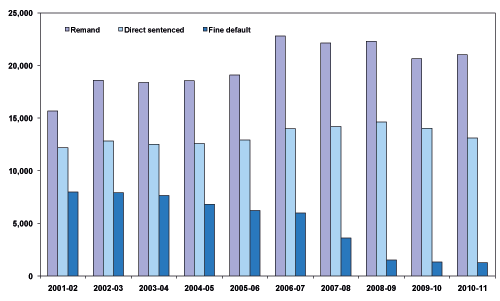
Direct sentenced receptions
20. The bulk of the general rise in direct sentenced receptions up to 2008-09 is due to increasing volumes of relatively low-tariff crimes and offences. These include handling offensive weapons, drugs-related crimes, crimes against public justice (such as contempt of court, perjury and bail offences), common assault and breach of the peace ( Table 12, see Section 5 for classification of crimes/offences). The rate of increase has been particularly marked since 2003-04, although, as noted above, the current figures indicate a degree of change in this medium-term trend. Receptions for crimes of violence have also increased over the past 20 years, mainly driven by a rise in receptions for serious assault and attempted murder: while the increase has been more gradual, these are crimes which tend to attract longer prison sentences and therefore have a bigger impact on the prison population. Trends for receptions by crime type are discussed in more detail in Scottish prison population projections: 2010-11 to 2019-20 (Annex A).
21. In terms of types of crimes and offences ( Table 12), the most notable areas of change over the past year are receptions for
- breach of the peace (down by 24 per cent to 1,054) [6]
- handling offensive weapons (down by 18 per cent to 884)
- crimes of dishonesty (down by 5 per cent to 3,517, with two fifths of the drop due to decreased receptions for shoplifting and housebreaking)
- crimes of violence (down by 4 per cent to 1,706)
- drugs related crimes (down by 6 per cent to 1,372)
- motor vehicle offences (down by 19 per cent to 559).
22. The average sentence length has fluctuated somewhat over the past 10 years, with a consistent increase over the past three or four years to a peak of 343 days for the past two years ( Table 13 and Chart 6).
Chart 6 Average sentence imposed (days): 2001-02 to 2010-11
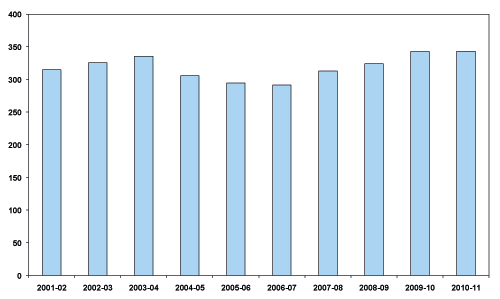
23. The shift in balance between less serious and more serious crimes highlighted in §20 appears to have had a short term impact on the average sentence length between 2003-04 and 2006-07 in terms of a drop in the average sentence length. However, the increase in receptions for crimes of violence over the past 20 years will have a greater impact on the prison population in the longer term as these tend to result in heavier sentences ( Table 12).
24. Receptions have fallen across all sentence categories over the past two years ( Table 13). However, this may not directly reflect actual sentencing behaviour as consecutive sentences are recorded as one sentence in prison statistics (see Section 5 for more details on counting conventions). Trends for receptions by sentence length are discussed in more detail in Scottish prison population projections: 2010-11 to 2019-20 (Annex A).
International comparisons of prison population
25. In terms of prison population per 100,000 population, Scotland ranked fourteenth highest with 153, similar to England and Wales (152) and Spain (159) ( Chart 7). This is higher than most other European Union countries, but substantially lower than the US, the Russian Federation and the Baltic states ( Table 16). Comparisons of the prison population in different jurisdictions should be treated with caution due to the different justice systems and recording rules in operation. Further details can be found in the Council of Europe Annual Penal Statistics ( SPACE) publications.
Chart 7 Incarceration rate per 100,000 population by jurisdiction: 2010
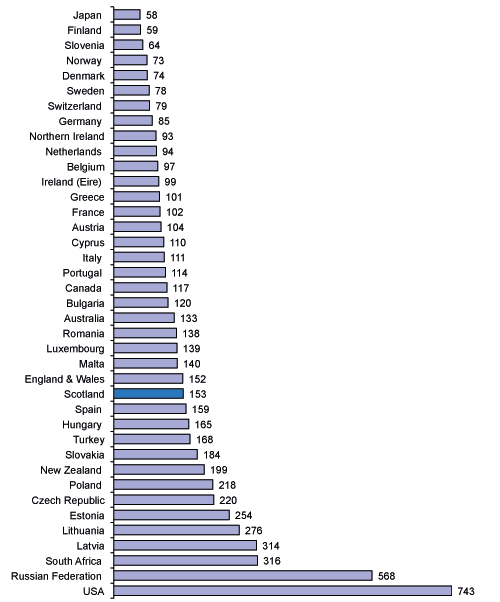
There is a problem
Thanks for your feedback